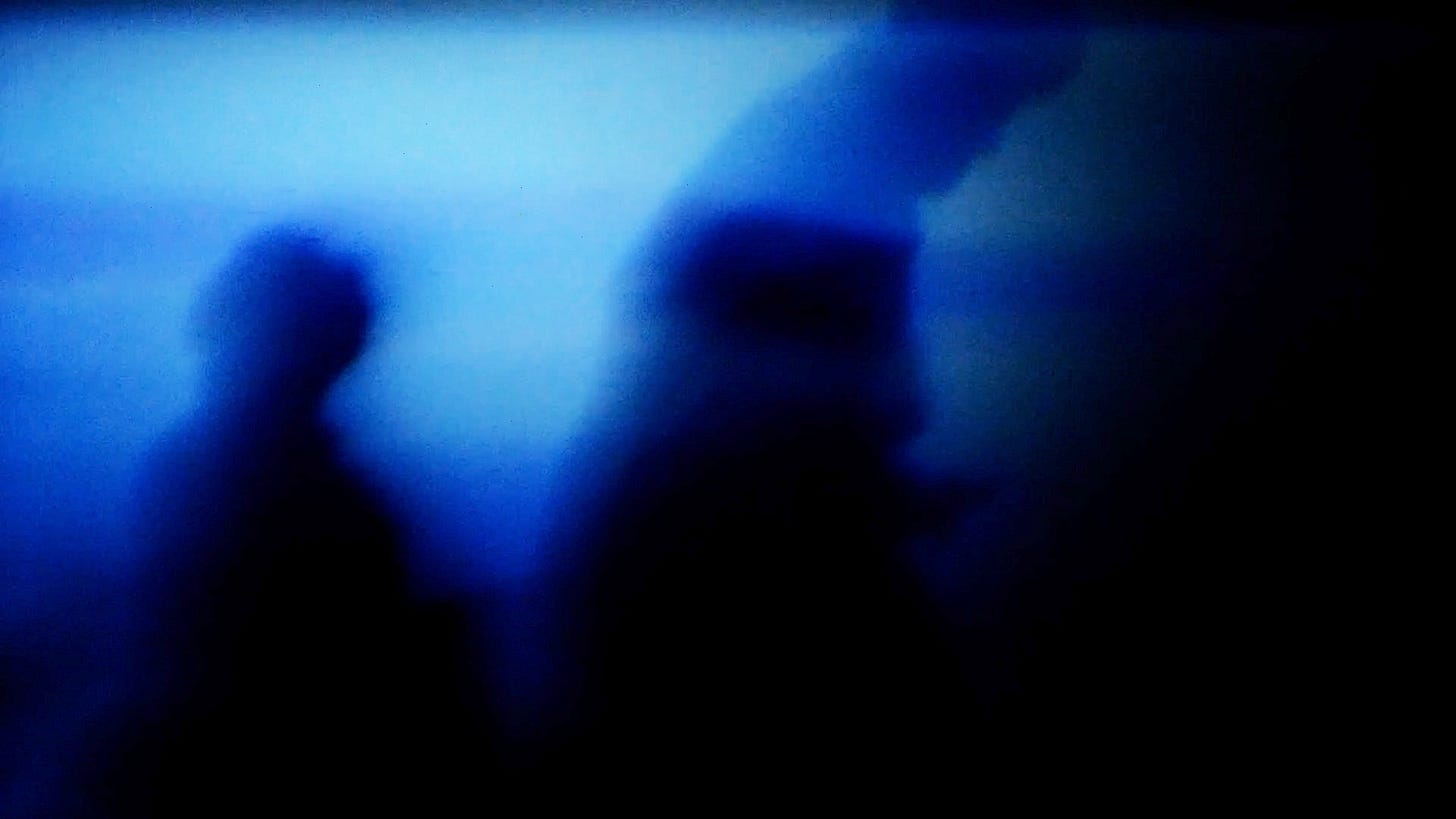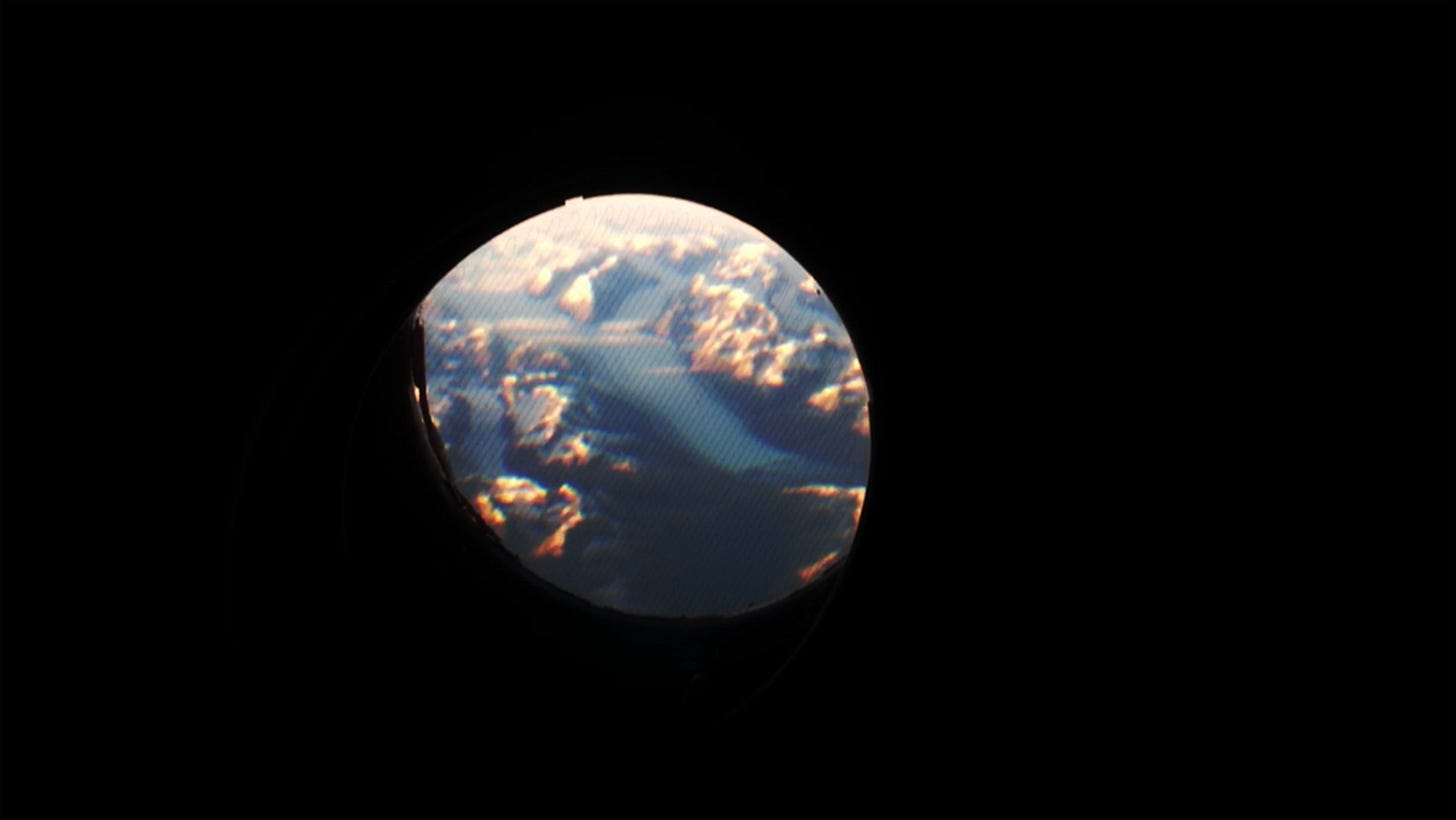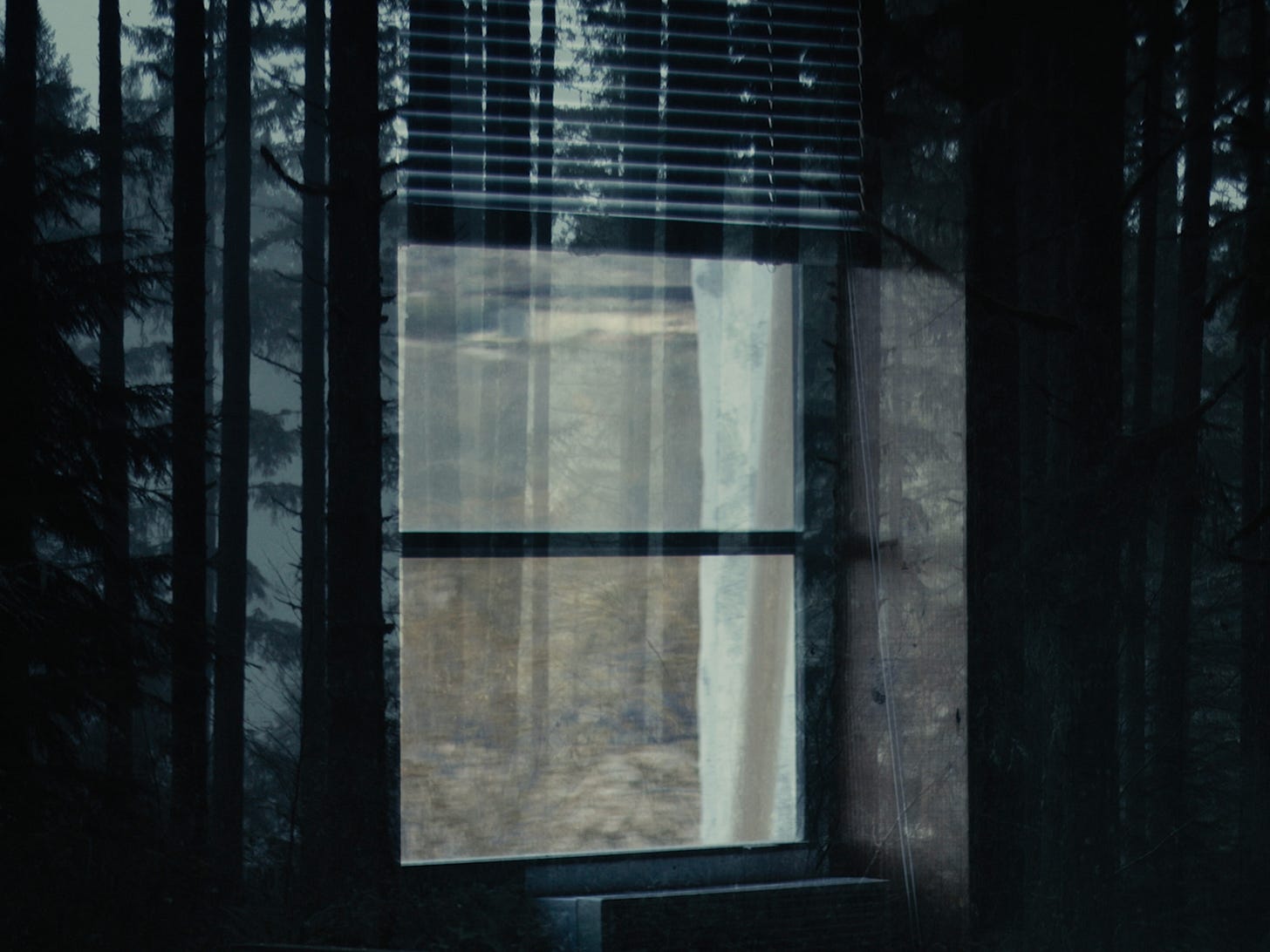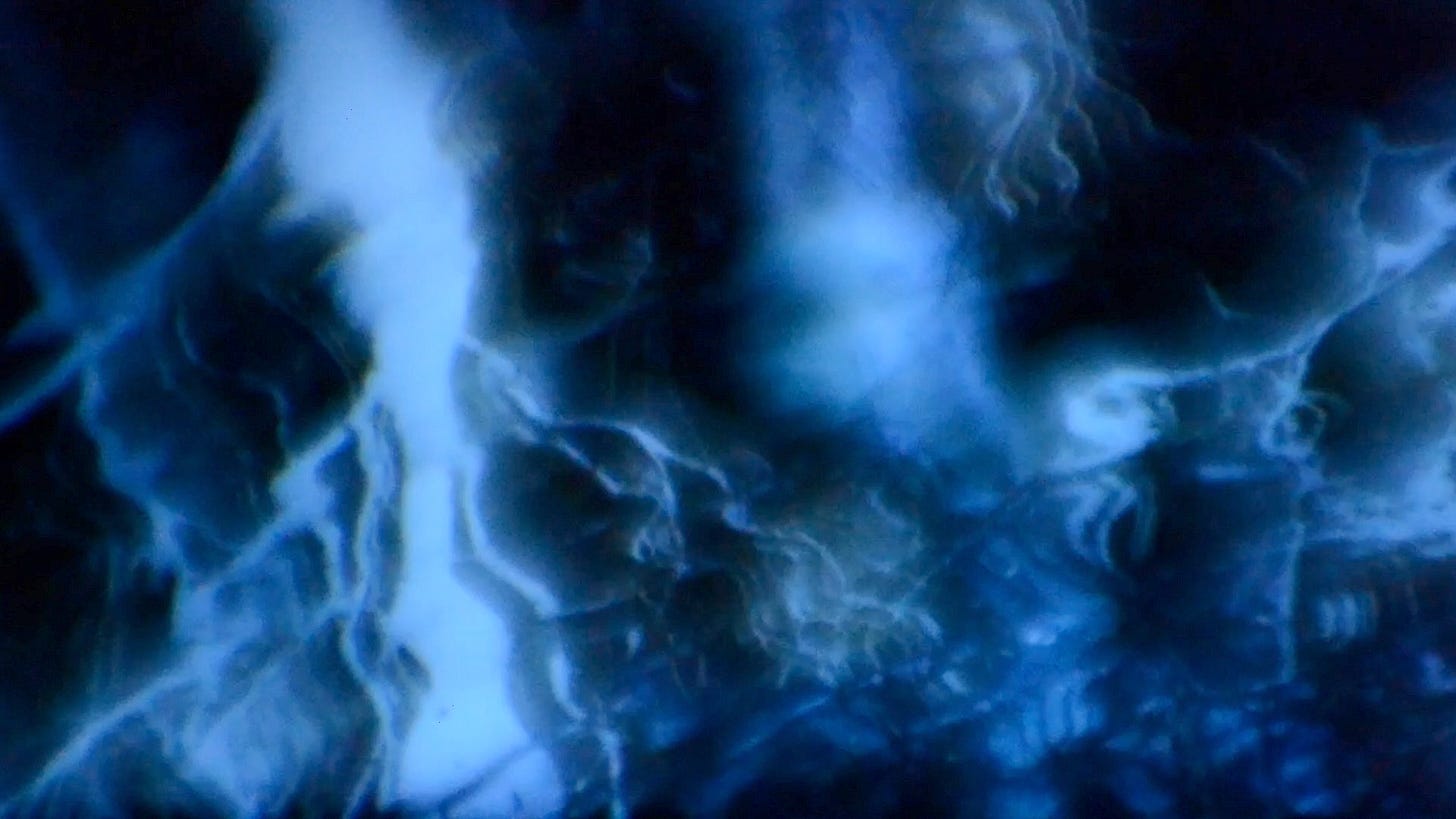Film Show 016: Prismatic Ground, 2022
Reviews of 16 films from the 2nd edition of Prismatic Ground
Prismatic Ground is an impassioned and loving film festival founded by programmer Inney Prakash. Last year, its inaugural edition was inspiring simply for what it represented. Here was a completely new festival that was free to the public, available online to everyone around the world, and was highlighting works in under-represented avant-garde and documentary modes. While other major film festivals can feel redundant, with the worst programming feeling both uninspired and the product of groupthink (how many fests present works from the same big names?), Prismatic Ground served as a much-needed alternative.
Prismatic Ground’s second edition, which runs from May 4th to May 8th, moves into a hybrid mode this year with screenings taking place both online and in person in NYC. As before, there are a huge number of films: 13 “waves” that are essentially themed programs involving shorts and the occasional feature. It’s still a massive, laudable, and important festival, but working through the dozens of films at this festival did leave me thinking about a number of things.
More than anything, it was obvious that it wasn’t since last year’s Prismatic Ground that I had seen so many films in such a short span of time that were subpar at best and creatively bankrupt at worst. The overwhelming number of films is, by most programmer standards, massive. 13 programs across four days (in addition to centerpiece and closing films) is already a lot, but some of these waves are long enough to be a detriment to one’s ability to soak in what these films have to offer. While many of these waves hover in the two-hour zone (already a lot for the type of films presented), one in particular lasts a whopping 210 minutes. When you see this many films and the majority of them are underwhelming the diminishing returns can start to weigh on you. There were times when I was watching films and felt that the programming didn’t do the job of selecting the best work, and that I was left to figure out where the real gold was, especially for films that didn’t already get buzz at other fests.
This mode of thinking, however, is tricky. I am completely sincere when I say that artists need spaces to make and showcase art that legitimately sucks. No one should be expected to make incredible films right out the gate, or even several years into the game. Hell, most people will never make anything resembling a masterpiece, and that’s fine. The film festival industry is largely exploitative and insular, so for Prismatic Ground to allow opportunities for younger, newer, and/or “less-established” artists to present their films in a way that feels incredibly supportive is not just good, but necessary.
With all that said, there were several notable films at this year’s Prismatic Ground that you’ll find below. When I talked with Mark Cutler after writing our blurbs, we agreed that we ultimately really love this festival. In a sense, working through all these films is akin to the experience of hearing dozens of new-to-me albums on any given week, and feeling the simultaneous drudgery and joy of stumbling upon an obscure gem. Below, you’ll find 16 films that provided that same feeling. —Joshua Minsoo Kim
Contour (Fábio Andrade, 2021)
The description that accompanies Fábio Andrade’s Contour is nothing more than a quote: “Open the leaves I will see my body turned into flower.” These words are from Gabriel Joaquim dos Santos, the salt worker and self-taught architect from Brazil who spent decades of his life building the Flower House. This space was constructed from various found materials—shells, broken lamps, metal lids, etc.—and the result was an ongoing project that lasted from 1912 to 1985.
This lifelong commitment to something scrappy, distinct, and beautiful permeates Andrade’s short film. The first half employs rapid camera movements and a minimalist soundtrack—the latter is more about creating a sense of perpetual momentum than landing on some sort of end point. As rocks and shells on a beach’s shore cascade in a dizzying array of beige, white, and umber, the camera eventually fixates on the nearby water, its harsh splashes and foamy movements providing some semblance of repose. At its midpoint, Contour covers the screen in a fog-like grey, with light and movement still perceptible. What’s soon revealed is a small crab underneath, and then a song is heard in the distance: the Folkways gem “Sutukung Kumbu Sora Followed By Solo (Tomora Ba Tuning)” by Alhaji Bai Konte and Dembo Konte. It, like the images, have this invigorated feeling of constant loping. That the film begins with shell-shaped rocks is slick: Contour’s bookends grant a poetic understanding of how life and art are always intertwined, and that creation is an unceasing, neverending process. —Joshua Minsoo Kim
Global Fruit (G. Anthony Svatek, 2022)
The beginning of G. Anthony Svatek’s Global Fruit finds a man trying to maintain his grocery store during a blizzard. He pours salt on the sidewalk, shovels snow, tries to keep the tarp secure—none of it seems very pleasant. His toiling, however, does feel justified with the images that follow: varying fruits and vegetables, gilded with snow, flickering under fluorescent lights. When Global Fruit concludes with images after the snow has passed, we see streams of water on the road that swirl into a psychedelic mass. If there’s any sense of dread that permeates these five minutes, it’s offset by those still images, which are the only moments featuring a non-diegetic soundtrack—a soft organ-like ambience that highlights the sanctity of it all. Interestingly, we only see a brief glimpse of these non-native foods’ hushed beauty, and it’s far from what comes to mind when considering avant-garde film’s history. There’s no time for deep consideration of light as in Hollis Frampon’s Lemon or Larry Gottheim’s Corn, nor is there the sensual materiality of Thom Anderson’s Melting; instead, these images are there to provide a moment of reprieve. This, Svatek seems to suggest, is why we keep persevering through the drudgery of life. There’s a subtle irony, of course, in how all these imported foods are in fact contributing to increased carbon emissions and global climate collapse. —Joshua Minsoo Kim
Wasteland No. 3: Moons, Sons (Jodie Mack, 2021)
There are many differences between Wasteland No. 3: Moon, Sons and the other films in Jodie Mack’s Wasteland series, but the most important is that it doesn’t utilize rapid edits as a way to convey meaning through juxtaposition. In Wasteland No. 1: Ardent Verdant, alternations between circuit boards and poppies creates an evocative suggestion of life, death, and artifice. Wasteland No. 2: Hardy, Hearty cuts between images of flora trapped in ice cubes and plants that are completely dry, capturing the essence of rebirth after winter. Moons, Sons also finds leaves and flowers encased in ice, though here they’re in circular disks and not the sort of ice cubes one would put in a drink. Despite similar elements as Hardy, Hearty, this film is more concerned with death. Time-lapse footage shows the melting process, and the final image of each sequence shows everything in a state of dilapidation. As with the rest of Mack’s films, there’s this incredible sensitivity to color and composition that allows even objects that are still to feel lively, with every tiny movement feeling unexpectedly poetic. Seeing that all play out multiple times—and uninterrupted!—makes Moon, Sons one of her most purely pleasurable works. When she cuts to black, you feel the weight of the disappearance—of this caked mass of stems and petals, of pinks and yellows—gone forever. Mack captures life as a brief, beautiful marvel. —Joshua Minsoo Kim
Vecino Vecino (Camila Galaz, 2021)
Throughout Vecino Vecino, Camila Galaz shows archival footage from a 1986 documentary about the MAPU-Lautaro, a Chilean Marxist-Leninist organization whose members sought to instill revolutionary consciousness within the working class. What makes this film valuable is the way in which Galaz employs pedagogical strategies to show the links between past struggles and the present day. At one point, we watch and read about members of the Lautaro taking food from trucks and distributing it to the poor; Galaz, in a letter typed in English that is translated to Spanish via Google Translate, notes how she “can’t tell what is real and what is staged.” This confusion underlines the curiosity she wishes to invoke, and the impact that time and distance have in causing difficulty for younger generations to understand what’s happened in decades past.
As footage plays, there’s often text that appears in both English and Spanish. Crucially, these words are 1) handwritten, 2) incrementally translated, and 3) not presented in the most logical order in terms of their appearance onscreen i.e. they don’t arrive in a left-to-right, line-by-line fashion as one would expect with onscreen text. All of this forces viewers to concentrate, which in turn draws even more attention to the loss inherent in translation, and the amount of work really needed to comprehend anything that’s ever happened. (I’m reminded of my own poor Korean and how that makes researching the country’s revolutionary history more challenging.)
Later, we watch as instructional videos about shooting guns are replicated by Galaz, and these side-by-side images constantly link these time periods, and of the ongoing need to push back against state violence. Even when we move strictly into the present day and see Instagram Live footage of Chilean protests placed next to each other, there’s a sense that Galaz wants to show how it’s almost impossible to ever get the full scope of perspectives and contexts of any event. But despite this, there’s a current of fearlessness and dedication underlining everything, and the film ends with a woman stating, “I am not telling people to hide under their beds at home. I am asking people, not only for the life of my son, but for that of his people. To the mothers, to the fathers, for their children, for their grandchildren, who have to fight, who have to demand justice—this cannot continue.” This is revolution as a necessity, as a duty inherited from generation to generation. —Joshua Minsoo Kim
True Places (Gloria Chung, 2022)
I’ve watched Gloria Chung’s True Places five times now and I love the way its images continue to reside in my brain. This isn’t to say that I think about the way it looks, or even remember its various sequences in vivid detail, but that the ideas and atmosphere they conjure up are so evocative that they leave me in a state of post-viewing contentedness. It feels like the aftermath of listening to an enveloping ambient record and basking in its afterglow. Notably and importantly, True Places doesn’t have an overwhelming soundtrack—its audio is little more than a low-droning hum and the occasional recited text detailing climate change’s effects on Greenland and the Indigenous hunters who live there. While partially sourced from a New Yorker article, this information belies the fact that this is not a message film, or even a primarily educational one. Instead, this is about the peculiarity of memory and time and place, of the inevitable decay of the world and the inherit strangeness of the concomitant displacement—both physically, and as a result of one’s disconnect from the changing land. The title is sly: these are real things happening in real places, yes, but the images themselves are so gauzy that they can feel fictional. At times, images look like nothing more than bands of pastel colors. What even is this space? Is it Greenland? It’s in this questioning that one can empathize with the hunters’ loss. —Joshua Minsoo Kim
Madness Remixed (Rhea Storr, 2021)
Madness Remixed is a transfixing, slightly bewildering exploration of the life and significance of Josephine Baker, the famous Black entertainer who later became a vocal civil rights advocate and member of the French resistance. Storr conducts this exploration through the lens—I’m tempted to say from the perspective—of an iconic, scandalous garment: the sequinned ‘banana’ skirt which helped make Baker an international star in the 1920s, and which has been endlessly referenced, ripped off and parodied in the proceeding century. In addition to historical photographs and footage of Baker gamely performing in uncomfortably racist productions, as well as archival footage of industrialized banana plantations, Storr deploys a mix of spoken texts revolving around the racialized and capitalist exploitations of the ‘exotic’ by the white mainstream.
Threaded through all of this are long, dizzying passages of glimmering, golden light; I’m not really sure how these connect to the rest of Storr’s ideas, but they are very lovely as well. If Storr’s images don’t always seem to mesh on a thematic level, they are nevertheless always interesting, provocative, or both, and there was not a moment when I wasn’t intrigued. In its brief runtime, Madness Remixed offers a surprisingly expansive thesis on the intersections of entertainment and exploitation, across industries and continents, literally embodied in one woman and the ten inches of fabric around her waist. —Mark Cutler
The biggest reaction I had to Rhea Storr’s Madness Remixed was acknowledging the Brakhage-like collage of speckled yellows and greens and blacks as something removed from the pure beauty of color and light and movement. This is clear from the ambient soundtrack, which meanders with a palpable melancholy. Rhea Storr spends the runtime focusing on Josephine Baker’s banana skirt, and uses it as a launchpad to think about the links between exoticization, appropriation, and exploitation. When these more avant-garde sequences dissolve into those involving Baker dancing—themselves tinted in yellow—and data-moshed footage, there’s a clear channeling of of the thesis, which is spoken in voiceover: “We see the beauty of the culture but we don’t see the pain behind it.” We hear about melanotan, an injectable synthetic hormone that people can purchase and use to turn their skin a darker complexion. We also see clips from About Bananas, a 1935 film that shows the destruction of jungles to bring bananas to American markets. In following in the lineage of avant-garde film, and decoupling such images from notions of purely filmic principles, and then coupling it with an acerbic political polemic, Storr continually refocuses our attention to her impassioned anger and highlights that constant perspective-shifting is necessary when grappling with the fetishization and representation of Black people. —Joshua Minsoo Kim
Infinite Distances (Pablo Alvarez-Mesa, 2022)
Infinite Distances devotes its entire runtime to presenting found audio from different answering machine messages. Crucially, there are zero images in this movie, so all that’s present visually is a black screen. This situates Pablo Alvarez-Mesa’s film in a funny space between a gag and an austere formal exercise. I was reminded of various prank call albums, as this film falls somewhere between records that have a bunch of pranks presented as a loose collection, and something like Brandon Locher’s Conversations series, where each person he calls has their audio recorded and then played back to another person in an ongoing chain of unwitting prank calls. Infinite Distances has some sort of connective tissue between the different messages, but even then, there’s a sense that engaging with a movie—a piece of art that has a single, continuous stream of audio—encourages such desire for cohesion. Compare this with an album with a similar conceit and one can tell that the existence of multiple tracks subtly indicates to listeners that each message is a discrete entity.
The other, more obvious comparison one can make is with Ernst Karel & Veronika Kusumaryati’s Expedition Content. That imageless film, which has a more heady concept revolving around archival material from Robert Gardner, is one of the most interesting instances in which a filmgoer is forced to reckon with the relationship between sound and image in film (not to mention the hierarchy of director-subject and audience-film relationships). Infinite Distances, which is only showing at Prismatic Ground in person, is also committed to creating an experience that points to the peculiarity of the cinema in general. Here, when there is no image, the experience of listening to random messages like these with an expectation that one will sit through the whole film is incredibly unique, like being at a stand-up comedy show with nobody on stage, or an album-listening party except in a pitch-black room. I’m not entirely sold on the content of this film being arranged in a compelling or evocative manner, but the experience this will provide ensures it’ll be one of the most singular works one can experience at a cinema this year. —Joshua Minsoo Kim
Lake Forest Park (Kersti Jan Werdal, 2021)
At the beginning of Lake Forest Park, a film shot in the titular city located northeast of Seattle, we hear a news report that a teenager has died due to an accidental gunshot wound to the head. The remainder of this 60-minute feature captures the various locales and peoples in this space with a remarkable tenderness. The soundtrack, which is mostly moody reverbed guitar from Marisa Anderson, brings to mind the work of someone she’s collaborated with: William Tyler, and specifically his soundtrack for Kelly Reichardt’s First Cow. It has this forlorn spaciousness that is crucial to capturing the bleary mental state of everyone we see onscreen, but it’s never overbearing or saccharine.
This balance fits director Kersti Jan Werdal’s goal: With little care for an overarching narrative, she gave these first-time actors an idea of what would happen in a scene and then simply filmed what happened. The result is astounding: there’s a casualness to every scene and she’s able to capture and maintain this out-of-time atmosphere consistently. I’m reminded of my own periods of grieving, and how in that stark realization of life’s fragility and permanent loss, that every single conversation and action and day doesn’t feel particularly real. Werdal rarely focuses on people’s faces, nor are conversations ever clear enough to be something one feels forced to pay careful attention to; instead, everything—from the people to the places—feels like it’s on the periphery. While watching Lake Forest Park, there were moments when I felt compelled to look away from the screen. It’s not because the images were ever gruesome (they never are) or that it wasn’t beautiful (it always is), but because there’s a quietude here in both the images and sound that acknowledges the occasional need for being away from the world. —Joshua Minsoo Kim
The day lives briefly unscented (Brandon Wilson, 2021)
Brandon Wilson constructed this brief, brittle poem of a film by capturing and superimposing domestic imagery in short, uneven bursts. Dedicated to the filmmaker’s grandmother, The day nevertheless contains few concrete personal references. We occasionally see a photograph, a piece of furniture, what look to be differing views from the same house, but much of the imagery remains anonymous or unplaceable. Nevertheless, this film reminded me why superimposition—perhaps, after the cut, cinema’s oldest and cheapest special effect—remains so powerful: it expresses, perhaps more vividly than any other artform, the human tendency to yearn for the impossible. —Mark Cutler
Instant Life / Enthusiasm (OJOBOCA, 2022)
OJOBOCA have two films in the festival. Both films are characteristically gorgeous and beguiling, using documentary methods to concoct surreal and gruesome narratives which frequently veer into science fiction. Enthusiasm is a brief but powerful diptych, and something of an oddity in the OJOBOCA filmography. The first half consists of a lengthy quote about an antiquated Scottish ritual so horrific, I was sure it had to be another one of the filmmakers’ sci-fi fabrications. Unfortunately, it is not. The second half consists of a single shot of an animatronic cat, which nevertheless is scarcely less unsettling than the first. I quite enjoyed this film, and found it somewhat more focused than the relatively sprawling Instant Life—but animal lovers may want to avert their eyes.
Instant Life, meanwhile, is a film about crystals—or rather, about the arguably non-conscious but self-propagating structures of which crystals are an example. It might also be about crustaceans. In any case, the ‘seed’ of Instant Life’s recursive structure is a kind of riddle, articulated once but reflected in all three rehearsals of the film. Ostensibly one remake of three remakes of a lost 1941 film, Instant Life takes its aesthetic cues from the stately, but often subtly psychedelic BBC documentaries of the ’70s and ’80s. Everything from the imagery to the music to the title font feel like references, and the tripartite structure allows the duo to play liberally with call-backs and -forwards within the film itself.
However, Instant Life can be enjoyed without wandering into OJOBOCA’s metatextual labyrinth. Their always-beautiful 16mm photography is sharper and more saturated than ever, well-suited to the serrated stalactites and salt flats which occupy much of the film’s runtime. They make liberal use of rich, gradiented color-filters, which call to mind both the colorized reels of early silent cinema, as well as a VHS-taped, high-school educational film about chemistry or shrimp. As a work of speculative fiction, Instant Life is dense and rewards (or requires) multiple viewings. As a movie about crystals, it’s also great. —Mark Cutler
A Vessel, the Ideas Pass Through (Linnea Nugent, 2021)
Linnea Nugent’s A Vessel, the Ideas Pass Through is five minutes of alien-like figures and landscapes. At first, we see birds amidst complete blackness, and they glow with strange, colorful lights as if to portend something evil. Appropriately, the film continues with confounding images. There are these smears of blues and purples that at one point look like a watercolor painting of taproots projected on an analog television, then undergoing ghosting and other warping. There’s constant refocusing of the lens and flickers of light, bolstering the eeriness of every shadow. Even when images are clear, like the flowers near the end of the film, Nugent doesn’t allow enough to rest on their beauty to invoke any semblance of normalcy. Appropriately, the soundtrack is primarily this dotting drone, like hearing fractured radio frequencies and trying but failing to hear something clearly. That Nugent continually withholds such satisfaction in both sound and image makes A Vessel satisfyingly mysterious. —Joshua Minsoo Kim
One Survives By Hiding (Esy Casey, 2022)
This lovely, lugubrious lament of a film takes us backwards and forwards through the filmmaker’s life, parents’ lives, and history of what I presume to be the Clark Air Base, the former-U.S. air force base on Luzon, in the Philippines. The atrocities which our government visited (and in many ways, continue to visit) upon the Filipino people have still scarcely come to light. For the victims and their descendants, there is no public record, no media attention, and less than no chance of justice or restitution. One Survives By Hiding grapples admirably with this history, spinning relatively few images into a tissue of memory and pain. —Mark Cutler
Dreams Under Confinement (Christopher Harris, 2021)
When I interviewed Christopher Harris, I was struck by a specific point he made regarding continuity editing, that it “creates a phenomenological experience for the viewer that is, in effect, analogous to the spatiotemporal experience of whiteness.” In essence, when one views a film, there’s an understanding that “the viewer is always in the right place at the right time.” This, Harris told me, is “antithetical to the idea of Blackness” because “Blackness is always in the wrong place at the wrong time.”
One facet of Harris’s career is in finding a way to honestly depict Black experiences in America via thoughtful considerations of editing. With Dreams of Confinement, his first entirely digital film, he utilizes Google Earth footage of Chicago and couples it with frantic police dispatcher audio. More than two and a half hours of sound is edited down to the film’s two minute runtime, and the frenetic pacing of these voices and his own frazzled navigation of the city—presumably trying to find the specific locations that are discussed by the cops—instills deep anxiety and hostility. As the satellite footage mainly shows off the buildings and businesses in this locale—people are inherently not going to be the focus of any sort of program like this, and faces are obviously going to be blurred—there’s a reminder of how the police state functions. First, it points to how cops primarily exist to protect property, and specifically that which is is owned and caters to the white elite. Second, it shows the absolute ferocity and speed with which they’ll track down Black people for punishment and how that same energy is rarely used to lift Black communities up when they need support. It’s a jolting two minutes. —Joshua Minsoo Kim
Signal and Noise (Katie Mathews & Jess Shane, 2022)
Katie Mathews & Jess Shane’s Signal and Noise is bolstered by being sequenced right after Dreams Under Confinement, as this is another film whose audio plays a crucial role in depicting violence enacted by the state. The sounds we hear were gathered by Jordan Scott, a poet who went to Guantánamo Bay in 2015 to record the sounds of the prison. While the facility invites journalists to come on media tours for the sake of “transparency,” it’s mentioned that the focus of such trips is on the visual. Signal and Noise aims to highlight the aural terrors that exist here—something that is generally not considered when thinking about torture of any kind.
Throughout Signal and Noise, we hear (and hear about) vacuums running in front of cells, and the incessant fans in these spaces that prevent the chance for complete silence. There is, in effect, no moment for one to be truly at ease or think without disruption, and the nonchalance with which one guard mentions these sounds reveals ostensible ignorance regarding audio as violence. Most compelling is how we learn about something that the people at GTMO want to hear: the ocean. It can be heard at the recreation center, but when former detainee Mansoor Adayfi recalls removing a tarp to hear it more clearly, it’s noted that he was punished for doing so. There’s no access to even the semblance of freedom, even one suggested by the sound of waves. When a guard leads Scott and other media people away, he does so on a boat while the sun sets and Andrea Bocelli’s “Time to Say Goodbye” plays—a perverse move that contrasts greatly with the aural reality of those imprisoned. At the beginning of the film, we see a quote from R. Murray Schafer’s The Music of the Environment: “Noises are the sounds we have learned to ignore.” Signal and Noise proposes a question: What if the only sound one can focus on is noise? —Joshua Minsoo Kim
Color Without Color (Phyllis Baldino, 1999)
A few years ago, I was talking my friend about synesthesia when he stopped and laughed. “How could anyone think someone else’s experiences are gonna be the same as their own,” he told me. This was a conversation that was ultimately tied back to politics (and the gall for political figures to believe they can speak on behalf of those completely unlike them), but it’s something that speaks to the foolishness of how many people approach art in general. There is an inherently unique context with which any single person engages with a piece of art, and it’s informed by the history of art that they’ve previously consumed, their cultural upbringing, their aesthetic values, and so on. But so often people fail to remember that any evaluation of art doubles as an unveiling of the person’s specific context, and that it can be a worthwhile exercise to think about these two ideas in conjunction.
This all came to mind when watching Phyllis Baldino’s Color Without Color, a film that aims to showcase the lived experiences of people with achromatopsia, a visual disorder that can lead to people only seeing black, white, and shades of grey. We indeed hear a story about synesthesia near the film’s beginning, with someone noting that they connect specific colors to musical notes, but there’s also a lot of free association going on: a color appears onscreen, and people talk about the objects or moods that come to mind. All color is associated with something in our mind, but then someone explains that “colors lie to you.” They expand: “Bananas are yellow, except when they’re green. Apples are red, except when they’re green.” It’s a reminder of how so many concepts are linked together throughout our lives, even when we know exceptions exist. And the same is true for those who don’t see colors at all: “[Color] is not really anything to me; it’s the reaction that you have to it and the reaction I have to your reaction to it.” It’s a secondhand linkage, but how much of our ideas are learned secondhand, anyway? When we hear a story about a blind person telling someone that their aura is “lavender,” it may seem preposterous, but there are specific connotations that are paired with that color.
Color Without Color utilizes a circular frame—interesting in and of itself as something that predates recent films incorporating a similar frame (Gust Van Den Berghe’s Lucifer, Feng Xiaogang’s I Am Not Madame Bovary, Johnny Clyde’s The Forgotten Colours of Dreams)—but it also recalls looking through a microscope. What’s funny is that so much of what’s seen is rather plain—various objects one would find in a home—but the lack of color actually mystifies and obfuscates what they really are at times. One then starts to understand achromatopsia not necessarily as a deficiency as much as a different mode of viewing: the exact sort of way we should think about our distinct experiences of the world. —Joshua Minsoo Kim
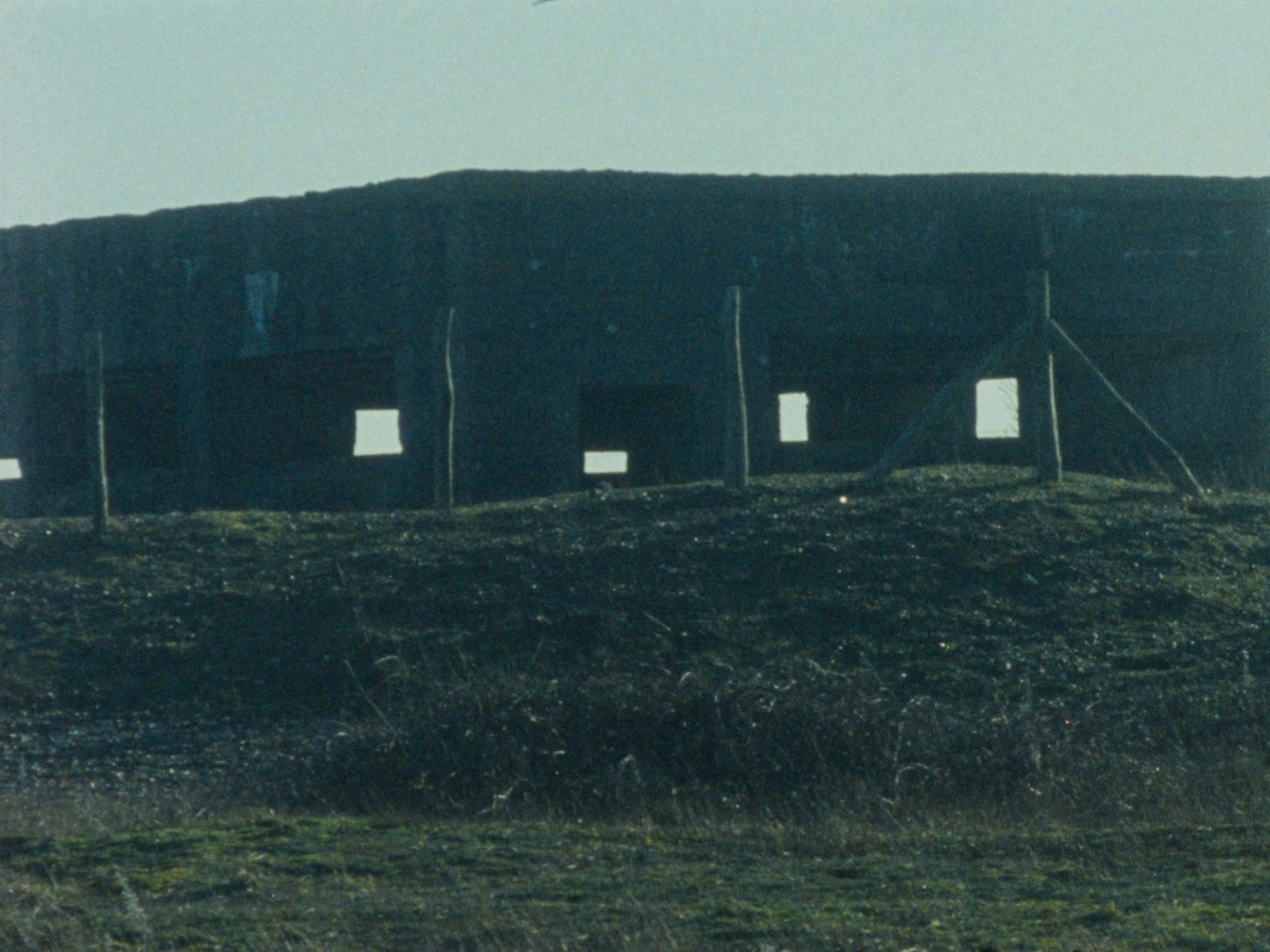
Thank you for reading the sixteenth issue of Film Show. More festivals like Prismatic Ground, please.
If you appreciate what we do, please consider donating via Ko-fi or becoming a Patreon patron. Film Show is dedicated to forever providing its content for free, but please know that all our writers are paid for the work they do. All donations will be used for paying writers, and if we get enough money, Film Show will be able to publish issues more frequently.



